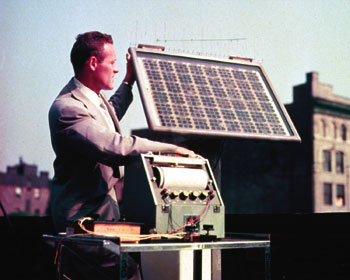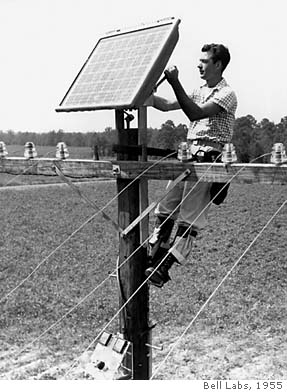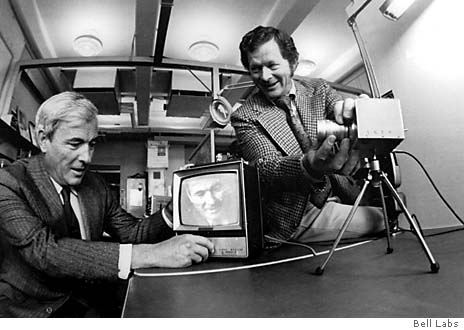 |
The Solar Battery (Photovoltaics)

Bell Labs engineer testing solar battery in 1954
- from
Bell Labs website

The original Bell Solar Battery (photovoltaic panel)
is used in an early test in 1955 in Americus, Ga.
This topic has always fascinated me since I was old enough to
spell "solar battery" many decades ago, long before this country knew we were
headed for trouble because of our dependence on foreign oil supplies. In fact,
my dream since the mid 1970's has been to live in a solar powered home and drive
an electric car recharged from solar panels by the time I retire. The USA will
never prosper again until we totally free ourselves from our dependency on
oil from the terrorist countries in the Middle East. Oil is literally a
dinosaur technology and yet we continue to subsidize this archaic fuel supply
when we should be funding research and production improvements in renewable
energy source systems - especially solar! Now for a little history of the
solar battery and Bell Labs involvement about 50 years ago.
In the early 1950s R.S. Ohl discovered that sunlight striking
a wafer of silicon would produce unexpectedly large numbers of free electrons.
In 1954, G.L. Pearson, C.S. Fuller, and D.M. Chapin created an array of several
strips of silicon (each about the size of a razor blade), placed them in
sunlight, captured the free electrons and turned them into electrical current.
This was the first solar battery. It could convert only six percent of the
sunlight into useful energy. - Source:
AT&T web
page.
Fifty years ago, scientists at Bell Laboratories unveiled the
first modern solar cell, using a silicon semiconductor to convert light into
electricity. See magazine advertisement for this new Bell Labs technology. A similar
advertisement can be viewed by clicking
HERE.
Also, check out the May 3rd 1954 Time article and the
July 4th1954 Time
article.
Their demonstration inspired a 1954 New York Times article to
predict that solar cells would eventually lead "to the realization of one of
mankind's most cherished dreams -- the harnessing of the almost limitless energy
of the sun.''
As early as 1962, when Bell solar cells powered
Telstar, the world's first
communications satellite, photovoltaic arrays have been recharging batteries and
powering equipment in space. But the space market was small and never created
enough demand for solar cells to drive down costs. That's why solar cells
remained pricey, while computer chips, their cousins in the semiconductor world,
became affordable so fast.
Over the last 20 years, improvements in manufacturing techniques gradually
lowered the costs of solar cells. That has widened their use, which in turn has
led to further expansions in the market and further economies of scale.
Meanwhile, for those sick of promises and wondering what solar cells have done
for them lately, David Bishop, research vice president for Bell Labs, said one
need look no further than the fiber-optic Internet.
Working in conjunction with another Bell invention, the laser, "The solar cell
is the heart of all optical communication,'' he said.
Conceptually, it's simple. Electronic data from computers are routed to a laser,
which converts the information to photons and pumps them through glass
filaments. At the receiving end, a charge-coupled device -- an invention that
operates on the same principle as the solar cell -- converts those photons back
into electrons and electronic data.
So if the solar cell hasn't lived up to its energy-producing promise, it has
played a vital role in creating the fiber-optic network "that can let any human
being talk to any human being anywhere,'' Bishop said.

Bell Lab researchers Willard Boyle (left) and George Smith devised what would
become the charge-coupled device in a discussion of less than an hour in 1969.
Photo courtesy of Lucent Technologies Inc.
TIMELINE
-
1954: On April 25, Bell Labs unveils a solar battery
that converts light into electricity.
-
1955:
The first field trial of a rural telephone system making use of transistors
and the Bell Solar Battery was held in Americus, Georgia. The Bell Solar
Battery was installed on a part of this trial system in October, 1955,
as an experimental substitute for ordinary batteries. Bell System engineers
have ascertained from the Georgia tests that, from the standpoint of
reliability and effective operation, the Bell Solar Battery mounted on a
pole can be used to furnish electricity for rural telephone equipment.
However, until raw material, technology and electrical storage become less
expensive, it will be more economical to use conventional power sources for
telephone systems.
-
1962: 3,600 solar batteries power the world's first
communications satellite, Telstar.
-
1969: Bell scientists adapt solar principles to
translate electronic data into light energy, leading to the charge-coupled
device, or CCD, now used in digital cameras and the Internet.
-
1973: Arab oil embargo shocks the U.S. economy and
awakens interest in solar energy.
-
1976: Solar power estimated to cost $55 per peak watt.
Incoming President Jimmy Carter pushes short-lived subsidies to kick-start
industry.
-
1984: Solar power estimated to cost $12.26 per peak
watt.
-
1992: The United States leads the world in total power
derived from solar cells, generating 43,500 kWp (kilowatts at peak), followed by
Japan with 19,000 kWp and Germany with 5,619 kWp.
-
1997: Japan takes the lead with 91,300 kWp of
installed solar power, passing the United States with 88,200 kWp and Germany
with 41,890 kWp.
-
2001: Japan expands its lead with 636,842 kWp of
installed solar power, while Germany's 260,600 kWp passes the United States'
167,800 kWp. Demand pushes solar power's estimated cost down to $3.50 per peak
watt.
(Peak watt prices in 2001 dollars.)
Sources: Bell Laboratories, Energy
Policy journal (1976 and 2001 solar power prices, in 2001 dollars), Worldwatch
Institute (1984 solar power price, in 2001 dollars), International Energy Agency
(total solar power by nation).

We Offer Personalized One-On-One
Service!
Call Us Today at (651) 787-DIAL (3425)


Some links on Photovoltaics:
The U.S. Department of Energy:
https://www.energy.gov/eere/solar/solar-energy-technologies-office
The U.S. Department of Energy- The History of Solar
https://www1.eere.energy.gov/solar/pdfs/solar_timeline.pdf
Natural Resources Canada
https://www.nrcan.gc.ca/energy/energy-sources-distribution/renewables/solar-photovoltaic-energy/solar-resource-data-available-canada/14390
Canadian Solar Industries Association
http://www.cansia.ca/
Sandia's National Laboratory's Photovoltaic Systems
Research & Development Programs:
https://energy.sandia.gov/programs/renewable-energy/photovoltaic-solar-energy/facilities/photovoltaic-systems-evaluation-laboratory-psel/
ENF (Energy Focus).
A website that
is an industry focused database of solar power companies and provides the
latest solar business and technical news plus having a list of government
solar power contracts:
https://www.enfsolar.com/
Solar Industry News.
Solar Industry offers
industry participants probing, comprehensive assessments of the technology,
tools and trends that are driving this dynamic energy sector. From raw
materials straight through to end-user applications, we capture and analyze
the critical details that help professionals stay current and navigate the
solar market:
https://solarindustrymag.com/
The Solar Energy Industries Association® (SEIA).
is leading the
transformation to a clean energy economy, creating the framework for solar
to achieve 30% of U.S. electricity generation by 2030. SEIA works with its
1,000 member companies and other strategic partners to fight for policies
that create jobs in every community and shape fair market rules that promote
competition and the growth of reliable, low-cost solar power. Founded in
1974, SEIA is the national trade association for the solar and solar +
storage industries, building a comprehensive vision for the Solar+ Decade
through research, education and advocacy:
https://www.seia.org/
Solar Builder Magazine.
is a B2B media brand specializing in the residential, commercial and
utility-scale U.S. solar markets. Benjamin Media and Solar Builder have been
a trusted source for the latest solar news in North America since 2011:
https://solarbuildermag.com/

|

